
Glyptothek
Encyclopedia
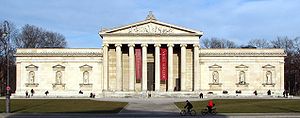
Munich
Munich The city's motto is "" . Before 2006, it was "Weltstadt mit Herz" . Its native name, , is derived from the Old High German Munichen, meaning "by the monks' place". The city's name derives from the monks of the Benedictine order who founded the city; hence the monk depicted on the city's coat...
, Germany
Germany
Germany , officially the Federal Republic of Germany , is a federal parliamentary republic in Europe. The country consists of 16 states while the capital and largest city is Berlin. Germany covers an area of 357,021 km2 and has a largely temperate seasonal climate...
, which was commissioned by the Bavaria
Bavaria
Bavaria, formally the Free State of Bavaria is a state of Germany, located in the southeast of Germany. With an area of , it is the largest state by area, forming almost 20% of the total land area of Germany...
n King Ludwig I
Ludwig I of Bavaria
Ludwig I was a German king of Bavaria from 1825 until the 1848 revolutions in the German states.-Crown prince:...
to house his collection of Greek
Greece
Greece , officially the Hellenic Republic , and historically Hellas or the Republic of Greece in English, is a country in southeastern Europe....
and Roman
Rome
Rome is the capital of Italy and the country's largest and most populated city and comune, with over 2.7 million residents in . The city is located in the central-western portion of the Italian Peninsula, on the Tiber River within the Lazio region of Italy.Rome's history spans two and a half...
sculpture
Sculpture
Sculpture is three-dimensional artwork created by shaping or combining hard materials—typically stone such as marble—or metal, glass, or wood. Softer materials can also be used, such as clay, textiles, plastics, polymers and softer metals...
s (hence γλυπτο- glypto- "sculpture", from the Greek verb γλύφειν glyphein "to carve"). It was designed by Leo von Klenze
Leo von Klenze
Leo von Klenze was a German neoclassicist architect, painter and writer...
in the Neoclassical style, and built from 1816 to 1830. Today the museum is a part of the Kunstareal
Kunstareal
The Kunstareal is a museum quarter in the city centre of Munich, Germany.It consists of the three "Pinakotheken" galleries , the Glyptothek, the Staatliche Antikensammlung , the Lenbachhaus, the Museum Brandhorst and...
.
History
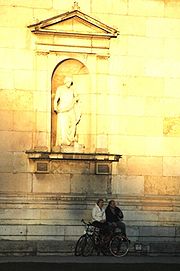
Königsplatz
Königsplatz is a square in Munich, Germany.-Architecture:The square was designed with the creation of the Brienner Straße at the command of Crown Prince Ludwig of Bavaria by Karl von Fischer and laid out by Leo von Klenze....
and the building which houses the State Collection of Greek and Roman Antiquities
Staatliche Antikensammlungen
The Staatliche Antikensammlungen in the Kunstareal of Munich is a museum for the Bavarian state's antique collections for Greek, Etruscan and Roman art. The Bavarian state collection of Ancient Egyptian art is traditionally placed in its own museum...
, as a monument to ancient Greece. He envisioned a "German Athens", in which the ancient Greek culture would be remembered; he had this built in front of the gates of Munich.
The layout of the Königsplatz complex was designed by the architects Karl von Fischer
Karl von Fischer
Karl [Carl] von Fischer was a German architect. His drafts had enormous influence on the architecture of classicism in South Germany....
and Leo von Klenze
Leo von Klenze
Leo von Klenze was a German neoclassicist architect, painter and writer...
in 1815, the latter arranged it in the style of a forum, with the Glyptothek on the north side. Colorful frescoes and stuccos made by distinguished artists such as Peter von Cornelius
Peter von Cornelius
Peter von Cornelius was a German painter.Cornelius was born in Düsseldorf.His father, who was inspector of the Düsseldorf gallery, died in 1799, and the young Cornelius was stimulated to extraordinary exertions...
, Clemens von Zimmermann
Clemens von Zimmermann
Clemens von Zimmermann, historical painter, was born at Düsseldorf in 1788; he studied in his native town under Johann Peter von Langer, and in 1808 he accompanied his master to Munich, where he entered the Academy. In 1815 he went to Augsburg, where he was appointed professor and director of the...
, and Wilhelm von Kaulbach
Wilhelm von Kaulbach
Wilhelm von Kaulbach was a German painter, noted mainly as a muralist, but also as a book illustrator. His murals decorate buildings in Munich.-Education:...
adorned the walls of the museum.
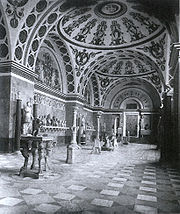
Medusa Rondanini
The over-lifesize Medusa Rondanini, the best late Hellenistic or Augustan Roman marble copy of the head of Medusa, is rendered more humanized and beautiful than the always grotesque apotropaic head of Medusa that appeared as the Gorgoneion on the aegis of Athena...
, the Barberini Faun
Barberini Faun
The life-size marble statue known as the Barberini Faun or Drunken Satyr is located in the Glyptothek in Munich, Germany. A Faun is the Roman equivalent of a Greek Satyr. In Greek mythology, satyrs were human-like male woodland spirits with several animal features, often a goat-like tail, hooves,...
, and, in 1813, the figures from the Aphaea temple on Aegina
Aegina
Aegina is one of the Saronic Islands of Greece in the Saronic Gulf, from Athens. Tradition derives the name from Aegina, the mother of Aeacus, who was born in and ruled the island. During ancient times, Aegina was a rival to Athens, the great sea power of the era.-Municipality:The municipality...
.
The Second World War did not destroy much of the artwork in the Glyptothek; but unfortunately the fresco
Fresco
Fresco is any of several related mural painting types, executed on plaster on walls or ceilings. The word fresco comes from the Greek word affresca which derives from the Latin word for "fresh". Frescoes first developed in the ancient world and continued to be popular through the Renaissance...
es did not survive and only lightly plastered bricks were visible after the museum was reopened in 1972. Since the Assyrian Hall erected in the inner court by Klenze in 1864 was not rebuilt, the Assyria
Assyria
Assyria was a Semitic Akkadian kingdom, extant as a nation state from the mid–23rd century BC to 608 BC centred on the Upper Tigris river, in northern Mesopotamia , that came to rule regional empires a number of times through history. It was named for its original capital, the ancient city of Assur...
n Orthostat reliefs from the palace of king Ashur-nasir-pal II
Ashur-nasir-pal II
Ashur-nasir-pal II was king of Assyria from 883 to 859 BC.Ashurnasipal II succeeded his father, Tukulti-Ninurta II, in 883 BC...
and a lion from the Ishtar Gate
Ishtar Gate
The Ishtar Gate was the eighth gate to the inner city of Babylon. It was constructed in about 575 BC by order of King Nebuchadnezzar II on the north side of the city....
of Babylon
Babylon
Babylon was an Akkadian city-state of ancient Mesopotamia, the remains of which are found in present-day Al Hillah, Babil Province, Iraq, about 85 kilometers south of Baghdad...
were moved into the Staatliche Sammlung für Ägyptische Kunst
Staatliche Sammlung für Ägyptische Kunst
The Staatliches Museum Ägyptischer Kunst in Munich is the Bavarian State Collection for Ancient Egypt art. It displays exhibits from all periods of Ancient Egypt's history. The associated small Middle East section displays objects from the areas of Assyrian and Babylonian culture...
.
Architecture
The museum was designed in the Classical Greek - Italian style. The portico is IonicIonic order
The Ionic order forms one of the three orders or organizational systems of classical architecture, the other two canonic orders being the Doric and the Corinthian...
, and the outer walls contain niches, in which 18 original Roman and Greek sculptures stand, six on each wall (except the back). The interior has domed vaulting.
The museum was originally built completely out of marble. However, during World War II
World War II
World War II, or the Second World War , was a global conflict lasting from 1939 to 1945, involving most of the world's nations—including all of the great powers—eventually forming two opposing military alliances: the Allies and the Axis...
the museum was bombed, and later reconstructed. The walls from the interior are composed of red brick and painted with a light plaster.
Collections
The Glyptothek contains sculptures dating from the archaic age (ca. 650 BC) to the Roman era (ca. 550 AD). Other notable sculptures, mosaics and reliefs can also be found here.This collection is complemented by the terracotta and bronze collections in the Staatliche Antikensammlung (State Collection of Greek and Roman Antiquities), which is located opposite the Glyptothek.
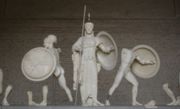
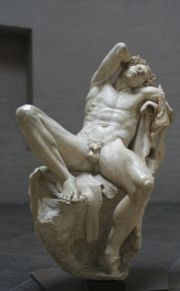
Archaic periodArchaic period in GreeceThe Archaic period in Greece was a period of ancient Greek history that followed the Greek Dark Ages. This period saw the rise of the polis and the founding of colonies, as well as the first inklings of classical philosophy, theatre in the form of tragedies performed during Dionysia, and written...
(700-490 BC)
Among the most famous sculptures covering this period are the Munich KourosMunich Kouros
The large grave statue of a youth from Attica known as the Munich Kouros is located in the Glyptothek in Munich, Germany.The archaic kouros was created about 540 BC. The statue with its heavy proportions and the short hair portrays an athletic ideal....
(statue of an adolescent from Attica, ca 540 BC), the Kouros of Tenea
Kouros of Tenea
The grave statue of a youth from Tenea known as the Kouros of Tenea is now located in the Glyptothek in Munich, Germany....
(statue of an adolescent from Corinth, ca 560 BC) and the temple figures from Aegina
Temple of Aphaea
The Temple of Afea The Temple of Afea The Temple of Afea (the name Afea appears on all the local signs, Afea being the name of a Cretan woman of unsurpassed beauty. After escaping a unwelcome marriage on Crete, she was rescued by a fisherman from Aegina. In payment for this he also proposed an...
(510-480 BC). Of the latter, there are in fact two sets of similar sculptures at the Glyptothek. As archeologists excavated the site at Aegina, these two sets were discovered, and it was later theorized that the original temple was destroyed during the Peloponnesian War
Peloponnesian War
The Peloponnesian War, 431 to 404 BC, was an ancient Greek war fought by Athens and its empire against the Peloponnesian League led by Sparta. Historians have traditionally divided the war into three phases...
and another temple was erected shortly after in its place. The Greeks had not bothered to clear the area, and had left the remains of the original temple buried at the same location.
Classical periodArt in Ancient GreeceThe arts of ancient Greece have exercised an enormous influence on the culture of many countries all over the world, particularly in the areas of sculpture and architecture. In the West, the art of the Roman Empire was largely derived from Greek models...
(490–323 BC)
To the most famous sculptures belong the portrait of Homer (460 BC), the Statue of Diomedes (430 BC), the Medusa RondaniniMedusa Rondanini
The over-lifesize Medusa Rondanini, the best late Hellenistic or Augustan Roman marble copy of the head of Medusa, is rendered more humanized and beautiful than the always grotesque apotropaic head of Medusa that appeared as the Gorgoneion on the aegis of Athena...
(440 BC), the Funeral stele of Mnesarete (380 BC), the Statue of Eirene (370 BC), the Alexander Rondanini (ca. 338 BC) and the Ilioneus (ca 320 BC).
Hellenistic period (323–146 BC)
The most famous sculpture representing this time is the Barberini FaunBarberini Faun
The life-size marble statue known as the Barberini Faun or Drunken Satyr is located in the Glyptothek in Munich, Germany. A Faun is the Roman equivalent of a Greek Satyr. In Greek mythology, satyrs were human-like male woodland spirits with several animal features, often a goat-like tail, hooves,...
(220 BC).
Among the famous Roman copies of Greek sculptures are the Boy with the Goose (ca 250 BC) and the Drunken Woman (attributed to Myron of Thebes; ca 200 BC).
Roman periodRoman sculptureThe study of ancient Roman sculpture is complicated by its relation to Greek sculpture. Many examples of even the most famous Greek sculptures, such as the Apollo Belvedere and Barberini Faun, are known only from Roman Imperial or Hellenistic "copies." At one time, this imitation was taken by art...
(150 BC - 550 AD)
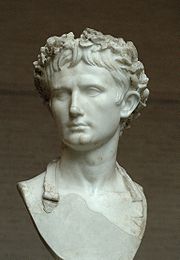
Bust (sculpture)
A bust is a sculpted or cast representation of the upper part of the human figure, depicting a person's head and neck, as well as a variable portion of the chest and shoulders. The piece is normally supported by a plinth. These forms recreate the likeness of an individual...
, among the most famous ones are the busts of the Emperors Augustus
Augustus
Augustus ;23 September 63 BC – 19 August AD 14) is considered the first emperor of the Roman Empire, which he ruled alone from 27 BC until his death in 14 AD.The dates of his rule are contemporary dates; Augustus lived under two calendars, the Roman Republican until 45 BC, and the Julian...
(ca 40 AD), Nero
Nero
Nero , was Roman Emperor from 54 to 68, and the last in the Julio-Claudian dynasty. Nero was adopted by his great-uncle Claudius to become his heir and successor, and succeeded to the throne in 54 following Claudius' death....
(65 AD), Septimius Severus
Septimius Severus
Septimius Severus , also known as Severus, was Roman Emperor from 193 to 211. Severus was born in Leptis Magna in the province of Africa. As a young man he advanced through the customary succession of offices under the reigns of Marcus Aurelius and Commodus. Severus seized power after the death of...
(200 AD) and his wife Julia Domna
Julia Domna
Julia Domna was a member of the Severan dynasty of the Roman Empire. Empress and wife of Roman Emperor Lucius Septimius Severus and mother of Emperors Geta and Caracalla, Julia was among the most important women ever to exercise power behind the throne in the Roman Empire.- Family background...
(195 AD). A heroised statue portrays Domitian
Domitian
Domitian was Roman Emperor from 81 to 96. Domitian was the third and last emperor of the Flavian dynasty.Domitian's youth and early career were largely spent in the shadow of his brother Titus, who gained military renown during the First Jewish-Roman War...
as prince (70/80 AD). To the major attractions belong also a colossal statue of Apollo
Apollo
Apollo is one of the most important and complex of the Olympian deities in Greek and Roman mythology...
(1st/2nd centuries AD) from a Roman villa in Tuscany, several Roman sarcophagus reliefs and mosaic floors.

